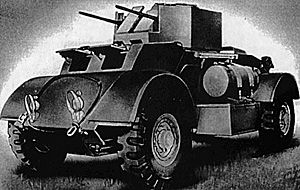 Divisional Reconnaissance Regiments
Divisional Reconnaissance Regiments
Early in the War armoured cars were to used for medium reconnaissance tasks but close and battle reconnaissance was to undertaken by one or more squadrons of light tanks from regiments within the division.
American produced Staghound AA version.
It was not until 1943 that production resources indicated sufficient surpluses for the planners to contemplate devising a unit specifically for recce tasks within an armoured division. Armoured specialists recognized that the ideal tool for the job was in fact an armoured regiment but it did not seem at the time that there would be sufficient tanks of the right kind for the job and other expedients had to be tried.
The first effort was announced in April 1943 and involved a unit with three fighting squadrons, each of three cruiser tank troops, each of one CS and two gun tanks, plus three carrier troops each of 4 carriers. This soon proved to be quite unsatisfactory and a second organization was announced in November of that same year, the Armoured Reconnaissance Regiment Type B. Although still not entirely satisfactory this was the best that planners could then contemplate, given production forecasts, and units in Italy did fight on this organization.
The Type B fielded a RHQ with 4 cruiser tanks, a HQ Squadron with AA, Recce, Intercommunication and Admin Troops, and three fighting squadrons. These comprised a squadron HQ of 2 cruisers, 2 CS tanks and a scout car plus a large admin tail for detached operations, with five troops each of 2 cruiser and 2 light tanks.
1st Derbyshire Yeomanry of 6th Armoured Division in Italy almost certainly fought on this establishment and 4th Hussars in 1st Armoured Division definitely did. On orders from Division, most of the turrets of the Hussars' light Stuart tanks were removed and a .50 machine gun mounted instead, thus trading in the dubious punch of the light 37mm gun for a lower profile and faster running. In assessing whether this was a successful trade it should be noted that around 80% of 4 Hussars' casualties came from these beheaded Stuarts.
In NW Europe the Type B remained the official establishment for an armoured divisional recce regiment until the end of the war. However, Montgomery insisted that he wanted an armoured regiment for the job and such was the power of a theatre commander at that time, shortages notwithstanding, he got his way. Thus Guards, 7 and 11 Armoured Divisions, along with 4 Canadian and 1 Polish Armoured Divisions, each fought with armoured regiments as their recce element.
Although in theory trained specifically for a reconnaissance role these regiments soon became in effect just another armoured unit and were used as such in "brigade groups" with one or more of the four infantry battalions in the division.
For example, 2 Northamptonshire Yeomanry, the armoured recce regiment in 11 Armoured Division, was disbanded after being badly mauled in early August 1944 and 15/19 Hussars, an ordinary armoured regiment totally untrained in reconnaissance tasks, was transferred at a few hours notice from training with 9 Armoured Division in the UK to replace them.
It was recognized that the Sherman was not an ideal vehicle for the recce task, being too big and not sufficiently fast or maneuverable and the ideal tank was thought to be the Cromwell. However, there was insufficient production of the type and in Canadian formations and in Italy the Sherman had to suffice. Initially the Cromwell recce regiments operated without the advantage of a 17pdr gun tank but by the end of August the Challenger became available.
In other respects the armoured recce regiment organization was that of a standard armoured regiment, with the exception that the two close support tanks officially with each squadron HQ were retained. (They had been dropped, again at Monty's insistence, in standard Sherman brigades).
British Reconnaissance Units of World War II Part 2: Armoured Divisional Formations
-
Divisional Reconnaissance Regiments
Armoured Car Regiments
GHQ Liaison Regiment, or "Phantom"
Regimental TO&Es (CD)
Appendix 1: CD UK Recce Vehicle Data Charts
Back to Table of Contents -- Command Post Quarterly # 13
To Command Post Quarterly List of Issues
To MagWeb Master Magazine List
© Copyright 1997 by Greg Novak.
This article appears in MagWeb.com (Magazine Web) on the Internet World Wide Web.
Other articles from military history and related magazines are available at http://www.magweb.com
